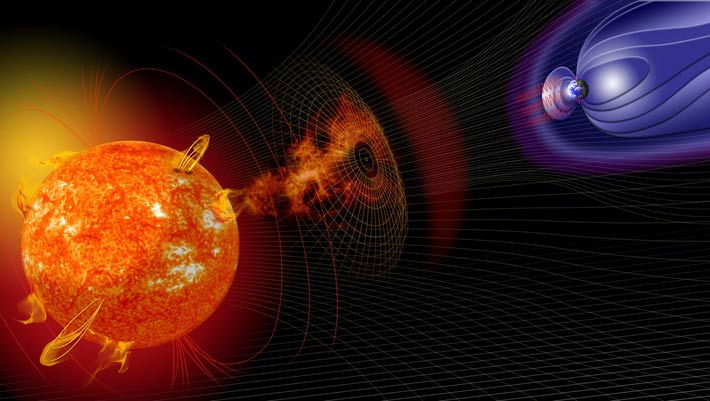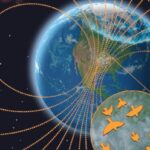In new research, scientists from the University of Leeds and elsewhere measured radiocarbon levels in ancient trees preserved within the eroded banks of the Drouzet River in the Southern French Alps. The tree trunks, which are subfossils, were sliced into tiny single tree-rings. The analysis of individual rings identified an unprecedented spike in radiocarbon levels occurring precisely 14,300 years ago. By comparing this radiocarbon spike with measurements of beryllium, the authors propose that the spike was caused by an extreme solar storm that would have ejected huge volumes of energetic particles into Earth’s atmosphere.
“Radiocarbon is constantly being produced in the upper atmosphere through a chain of reactions initiated by cosmic rays,” said Professor Edouard Bard, a researcher at the Collège de France and CEREGE.
“Recently, scientists have found that extreme solar events including solar flares and coronal mass ejections can also create short-term bursts of energetic particles which are preserved as huge spikes in radiocarbon production occurring over the course of just a single year.
“Extreme solar storms could have huge impacts on Earth,” said University of Leeds Professor Tim Heaton.
“Such super storms could permanently damage the transformers in our electricity grids, resulting in huge and widespread blackouts lasting months.”
“They could also result in permanent damage to the satellites that we all rely on for navigation and telecommunication, leaving them unusable. They would also create severe radiation risks to astronauts.”
Nine such extreme solar storms — known as Miyake events — have now been identified as having occurred over the last 15,000 years.
The most recent confirmed Miyake events occurred in 993 CE and 774 CE.
This newly-identified event occurred 14,300 years ago, and is the largest that has ever been found — roughly twice the size of these two.
According to the team, the occurrence of similar solar storms today could be catastrophic for modern technological society, potentially wiping out telecommunications, satellite systems and electricity grids — and costing us billions of pounds.
“Direct instrumental measurements of solar activity only began in the 17th century with the counting of sunspots,” Professor Bard said.
“Nowadays, we also obtain detailed records using ground-based observatories, space probes, and satellites.”
“However, all these short-term instrumental records are insufficient for a complete understanding of the Sun.”
“Radiocarbon measured in tree-rings, used alongside beryllium in polar ice cores, provides the best way to understand the Sun’s behavior further back into the past.”
“Radiocarbon provides a phenomenal way of studying Earth’s history and reconstructing critical events that it has experienced,” Professor Heaton said.
“A precise understanding of our past is essential if we want to accurately predict our future and mitigate potential risks.”
“We still have much to learn. Each new discovery not only helps answer existing key questions but can also generate new ones.”
“Finding such a collection of preserved trees was truly exceptional,” said Dr. Cécile Miramont, a researcher with IMBE at the Aix-en-Provence University.
“By comparing the widths of the individual tree rings in the multiple tree trunks, we then carefully pieced together the separate trees to create a longer timeline using a method called dendrochronology.”
“This allowed us to discover invaluable information on past environmental changes and measure radiocarbon over an uncharted period of solar activity.”
The study appears in the Philosophical Transactions of the Royal Society A.
_____
E. Bard et al. 2023. A radiocarbon spike at 14,300 cal yr BP in subfossil trees provides the impulse response function of the global carbon cycle during the Late Glacial. Philosophical Transactions of the Royal Society A 381: 20220206; doi: 10.1098/rsta.2022.0206





